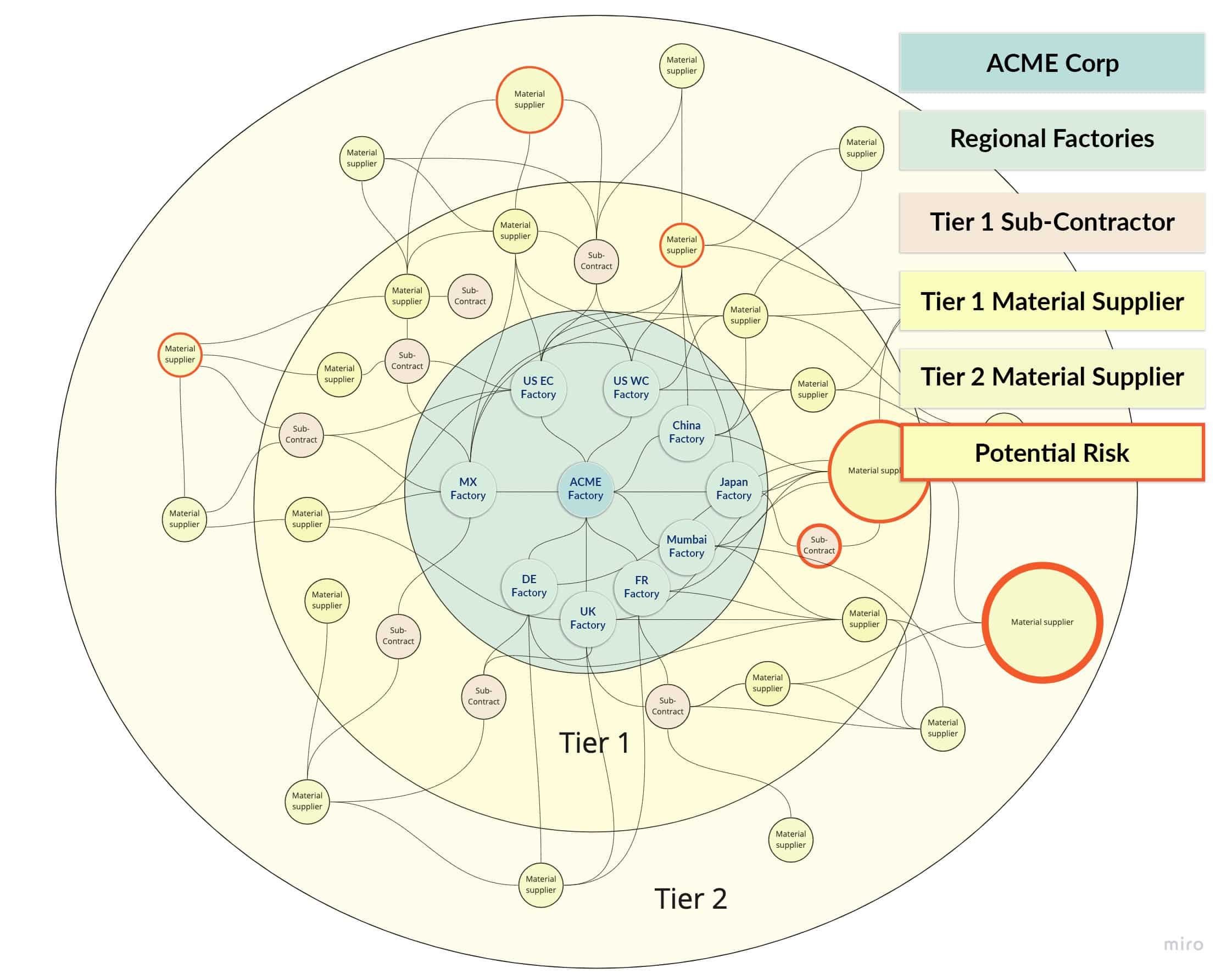Synopsis: The aftershocks of the ongoing pandemic make it obvious that it is impossible to properly respond to a crisis of this order of magnitude without establishing a transparent view of the multi-tier supply chain. Here is the three-step process to achieve just that.
Here is How to Secure Your Supply Chain
It is still too early to fully grasp the far-reaching ripple effects on the supply chains caused by the ongoing pandemic. However, we can already see that the global supply chains have been upended, disrupted, and transformed. Perhaps forever.
It has become painfully clear just how little visibility do the supply managers have into their supply chains. The domino effect from Tier 2+ manufacturers all the way up the supply chain has brought many industries to a complete standstill for the first time in decades. This chain reaction really drives home just how crippling this supply chain opacity can be for the business.
When the World’s Factory Suffers, We all Suffer
Wuhan, the region at the heart of the pandemic, plays an integral role in the global supply chain. Many manufacturers, as well as their suppliers, rely heavily on the factories in this region.
When the pandemic shuttered this global hub, major industries including optoelectronic technology, pharmaceuticals, biology engineering, and environmental protection, automotive, steel, and iron manufacturing had to scramble to mitigate the after-effects. Many had to halt production altogether.
For example, Fiat Chrysler Automobiles had to bring production at its Serbian factory to a standstill because it couldn’t get the parts it needed from China. Hyundai suspended production at seven plants in South Korea due to supply chain issues.
It’s estimated that over 50,000 global companies (of which 163 are Fortune 1000) have one or more Tier 1 suppliers in Wuhan, AND at least 5 million companies have one or more Tier 2 suppliers in the region.
The problem is that there is a universal lack of visibility into Tier 2 and Tier 3 suppliers, which makes adapting to drastic supply chain disruptions near to impossible.
Lack of visibility exposes manufacturers to risk
The aftershocks of the ongoing pandemic make it obvious that it is impossible to properly respond to a crisis of this order of magnitude without establishing a transparent view of the multi-tier supply chain.
While limited visibility into Tier-1 suppliers was the acceptable business practice before COVID-19, this is no longer enough. Faced with limited visibility, supply chain managers are not equipped to take action until the problem (that was generated 2+ levels down the line) is already affecting the Tier-1 supplier or even the company itself. At this point, it is already too late.
The pandemic and its after-effects are a reminder that to cope with such crises, it’s essential to establish a transparent view of a multi-tier supply chain. What is needed is full visibility of the supply chain network that reaches far into the supply chains. Transparency is needed to empower manufacturers to improve risk management, secure sourcing, and get actionable alerts before the problem becomes unmanageable.
But how can manufacturers achieve that?
Visibility and Digitization: The Missing Piece
Visibility and digitization go hand-in-hand. Without digitization, supply chain managers won’t have the insights or the visibility into their supply chain beyond Tier 1 suppliers. And this linear supply chain management model is no longer sustainable when faced with Black Swan events like the current global health crisis.
Establishing a transparent view of a multi-tier supply chain is one most pressing operational needs. Without access to accurate data and insights into the entire supply chain in real-time, supply managers can’t be expected to make timely decisions.
360-degree visibility into the supply chains will help manufacturers hedge against supply chain instability, and will ensure they have:
-
- Regulation compliance checks in place
- Active alarms
- Financial risk management
- Geographical risk management
- Better sourcing capabilities
Re-Imaging the Supply Chain
Supply chains are interconnected and complex systems built on the premise that supplies will always be available. Manufacturers rely heavily on the downstream suppliers, without having any visibility into those suppliers or what is going on below the deck.
This means that when faced with a crisis, supply chain managers cannot adjust and recover properly from supply chain disruptions. In order to prepare supply chains to cope with crises, and ensure that they can easily bounce back from any kind of disruption, we need to re-think our supply chain models.
Paving the Way For Supply Chain Resilience in a World of Black Swans
As I argued above, visibility is key to managing supply chain risks. Without proper monitoring and risk management tools that reach deep into the supply chain, companies are exposed to risks generated by tier 2+ suppliers.
Supply chain resilience is a process which consists of:
-
- Step 1: Create a supplier’s risk map
- Step 2: Perform online risk management
- Step 3: Enrich investigative capabilities
This three-step process is essential for supply chain resilience but also ensuring your supply chain is flexible enough to respond to challenges, disruptions and Black Swans.

Step 1: Create a Supplier’s Risk Map
Many manufacturers rely on either supplier managed inventory or supplier network collaboration. These are both company-to-company collaboration concepts and tools, which usually only provide limited visibility into Tier 1 suppliers.
What we need instead is a detailed, real-time risk map that extends across the entire supplier network. To achieve that, we need to create a “digital control tower,” a system for collecting all the necessary information in one place, signaling out the risky suppliers, and presenting the risks visually. The map would also include single source suppliers as well as risky suppliers with poor service.
An important part of this stage will be to communicate and map your suppliers according to their risk assessment. Mapping the suppliers will enable the creation of a graph map signaling Tier 2+ suppliers you are dependent on. Without even realizing it, some may become a major “Junctions” in the graph map, meaning they are the suppliers of your suppliers, and pose a bigger risk than realized.
As some suppliers will be reluctant to share this data, this will also signal out the low / high risk supplier in your supply chain.
Supplier’s risk map brings all suppliers across your supply chain into a visual model. By creating this map, manufacturers can identify weaknesses in their supply chain management and pinpoint problematic suppliers that leave them exposed to risks.

*Visual display of a supplier Risk-Map signaling high risk junctions / suppliers
Step 2: Perform Online Risk Management
The next step is to generate alarms to alert supply chain managers to any new threats to supply chain productivity. This can be achieved by using advanced analytics and machine learning tools.
Examples of alerts can include:
-
- A change in a supplier risk factor (based on automated risk assessment)
- New risks generated by delays in delivery
- Risks associated with manufacturing progress
- Risk identified based on changes in reporting quality
Step 3: Enrich Investigative Capabilities
At this stage we go beyond the initial risk map to extend our supply chain network beyond Tier 1 suppliers to Tier 2+ suppliers. Adding an exhaustive list of suppliers to the digital control tower is a long process and one that needs to be prioritized based on the initial supplier’s risk map. By diving deep into the supply chain we amplify risk-management capabilities by orders of magnitude.
At this stage it’s essential to go beyond Tier 1 suppliers especially with your highest risk suppliers. Once we have visibility and alerts on a real-time basis, we can go back to our supplier risk “control tower” and start adding more details to be accessible for further investigation of specific issues.
The future of supply chain management
We are likely to feel the effects of the current crisis on supply chains for years to come. As disruptive and chaotic as this supply chain upheaval has been, it has opened up the world of opportunities for all supply chain managers to transform the way they think about and approach supply chain management.
There may not be such a thing as a disaster-proof supply chain, but an agile supply chain which is capable of weathering the risks and adapting accordingly is within reach with the right technology.
To achieve 360 visibility, manufacturers must accelerate digital transformation initiatives while utilizing the best technologies for the task. With COVID-19 disrupting supply chains and manufacturing worldwide, now is the time to invest in tools that will empower agile response to future disruptions. Our manufacturing experts can help.
Consult with a Magic software specialist
This blog is written by Eli Peleg, Senior Manufacturing Consultant at Magic Software, and Amir Aloni, VP of Manufacturing at Magic Software.




